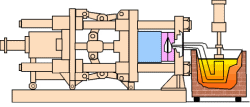Die Casting Molds and Die Casting Tooling for zinc die casting, or simply zinc tools, die casting mold is created from alloy tool steels with two sections at the least:
The fixed half mold (cover half)
The ejector half mold (this permits the removal of the die casting parts without compromising integrity).
Modern dies also feature actuated slides and cores that functions to produce under cuts, holes and other required shapes during the die cast process. Sprue holes within the fixed die half section permit molten metal to fill up the cavity without compromising the die. The ejector die half is where we find runners and inlets that serve as the molten metal’s route all the way to the cavity. Such molds also include the attached locking pins that secure the two die halves together with the ejector pins; this assists in removing the die cast part and the openings intended for the coolant and lubricant.
Whenever the zinc die casting machine closes up, both die halves will be locked and held together via the machine’s hydraulic pressure system. The surface part where both the fixed and ejector halves met and locked together is called the “mold parting line.” This should indicate that the projected surface area of the diecasting part, which is also measured up within the die parting line would govern the machine’s clamping force. This is also influenced by the machine’s pressure requirements when injecting metal towards the die cavities.
Zinc die casting tooling is also synonymous to zinc die die castings and insert dies. The concept itself is represented in different shapes, sizes and styles, with either single or multiple cavities. The cost considerations are influenced in part by the multiple cavity inserts and there are available trim dies.
Occasionally there are times when zinc die cast parts needed to undergo die cast trim tooling. Whenever a part is created through the zinc die cast tooling, a certain die casting trim called the “trim die” will be used to shear away any excess zinc from the parts. The process can present significant savings in the costs of die casting zinc parts since it has the ability to accelerate the production process of zinc die casting parts. The trim die is mounted onto the trim press forces the trim die halves together with high pressure to cut away excess materials using extreme mold pressure.
Also, the reason of zinc’s popularity as the preferred die cast metal of choice is its ductility and high impact strength that can be easily plated. Zinc is also considerably much less expensive compared to other metal alloys. The zinc diecasting process itself is inexpensive, and it does not compromise quality particularly in the end use levels. This makes it ideal for those small parts castings. The best part is that zinc alloy only needs a lower melting point in casting compared to others, which grants for greater flexibility.
Quality tooling for zinc die casting is best achieved with modern automated systems for ideal outputs. Manufacturers are confident their quality products will always produce because they relied on accurate computerized systems when die cast materials of the best metallurgical compositions. www.DieCastingZinc.com die casting tooling is complicated enough that it only needs the proper tools for delivering the best output.
Die Casting Zinc is a Zinc Die Casting Company which makes zinc die casting parts and tooling. We also have a Zinc Die casting Blog. Look at this website page for more details: www.diecastingzinc.com/zinc/. Contact us at 800-524-8083 or email us at sales@diecastingzinc.com


